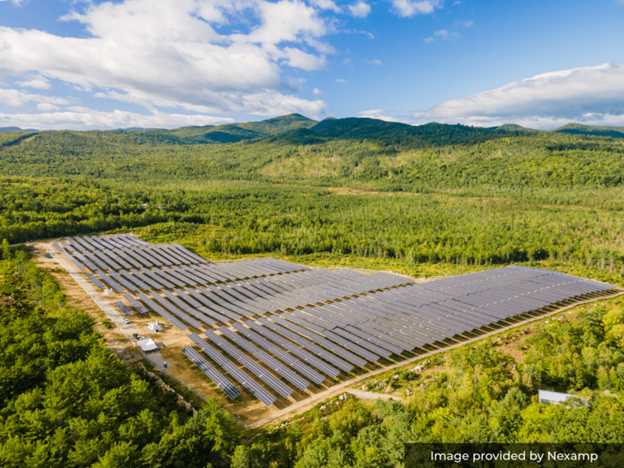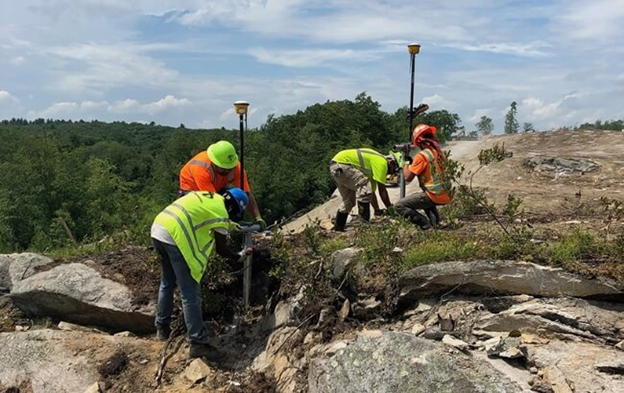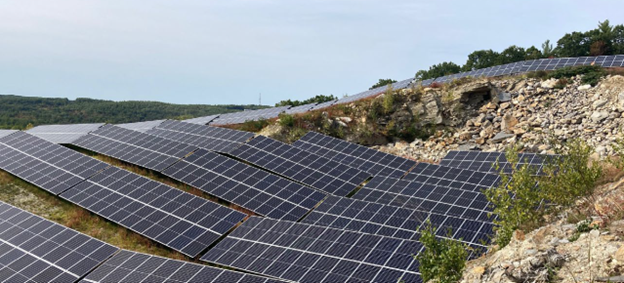
The solar industry’s steep growth curve brings with it unusual challenges, including the type of land available. Ideal sites—flat and soft terrain—are much harder to come by. So, developers of ground-mount systems are turning instead to rocky and hilly sites. Such land can be cheaper and produce higher margins, but only with the right expertise behind you—partners who understand the terrain and how to minimize risks.
At Terrasmart, we know tough terrain and wicked weather. With our deep experience, solid mounting portfolio, purpose-built feasibility software, and track record of reliability, you get the best racking fit for each and every site — no matter how challenging.
Here, we showcase how our tough foundations, adaptable racking, and smart trackers mitigate risks and ensure results, anywhere you need to go.
Project 1: Tracker system thrives despite harsh conditions
Maine’s historic town of Rumford is home to Rumford Solar, a project developed and built by Nexamp in partnership with Terrasmart. The 6.5-MW plant sits atop a bedrock of granite and endures annual snowpacks exceeding 25 inches that cover the region 59 days per year.
The site’s significant slopes — up to a 20% grade — plus winds up to 105 mph and 100 psf of snow pressure required adaptable racking with built-in flexibility. Additionally, frost depths up to 50 inches required a high front panel clearance of 45 inches.
While the front edge height requirement is not unusual in Maine, few single-axis trackers have the structural integrity and flexibility to use ground screw foundations while clearing this front edge height.
Tough soil, steep hills, and deep frost all pointed to ground screws as the only viable foundation to eliminate 100% of the refusal risks while protecting against frost heave, minimizing land grading, and slashing other civil expenses. Paired with Terrasmart’s adaptable racking designed for flexible land use, ground screws deliver reliable returns from unreliable sites.
Racks designed for optimal production and yield
Terrasmart engineers designed the project to maximize energy production and revenue. TerraTrak offers the unique pairing of an adaptable A-frame structure and ground screws, redirecting loads to favorable forces onto the foundations. Screw extensions also bring more versatility.
In this case, the SAT was designed to allow for 11% E/W and 20% N/S slope adjustments while providing a +/- 60-degree range of motion. Designing around bifacial modules meant incorporating multiple configurations of rows to fit within the site’s boundary and maximize yield.
Terrasmart was charged with installing the ground screws and racking systems during the fall and winter. Most of the work took place after the ground was frozen. Torque tubes and purlins were 25 inches higher than usual, while slippery ice and freezing conditions required extra manpower and frequent work stoppages.
Strategic measures made a difference in the schedule. Terrasmart used its proprietary ground screw machine to install the screws quickly and efficiently. TerraTrak’s telescoping screw extensions offered best-in-class field adjustability to help streamline the build on variable slopes.

The collaboration between the teams at Nexamp and Terrasmart thrived through the wintery conditions to deliver a more sustainable future for the community and support Maine’s renewable energy goals. The project — expected to offset more than 12 million pounds of CO2 annually — has proven to be a valuable economic investment, generating jobs, energy savings, and emission reductions.
Project 2: Project feasibility software makes Hawaii solar possible
Sun-rich Hawaii is an ideal solar market: With 1.5 GWs installed across 100 projects, solar generates 17% of the islands’ electricity.
The question is not “why solar” in Hawaii, but rather how best to make solar work.
Hawaii’s dramatic coastlines feature steep slopes that complicate PV construction. That’s why developers turn to Terrasmart’s Solar Instant Feasibility Tool (SIFT) to greenlight particularly challenging projects in the Aloha State.
Although many developers appreciate the software’s site layout function, SIFT offers multiple features for early-stage development such as system performance and financial modeling. The tool’s powerful computations can quickly assess how to generate maximum capacity on a site.
Users can run up to 500 spacing and DC:AC configurations, import accurate topography data from USGS and Google Earth, and conduct automated slope analyses. And when things inevitably change, developers return to SIFT to re-assess projects in just minutes, instead of waiting days for an engineering firm to rework the design.
SIFT helps developers move forward with confidence
When a leading US developer needed to identify the best tracking solution to optimize yield on a challenging site, it turned to SIFT for answers.
Located on an Oahu hillside with terrain challenges, the 30-MW site appeared too steep in some areas to accommodate single-axis trackers. But SIFT untangled the topographic complexity, avoiding the myriad design iterations that would otherwise have made the site’s development prohibitive.
The economics would not have worked with just fixed-tilt structures, which are the traditional safe bet. Instead, the tool’s topography feature confirmed that trackers with a 20% slope tolerance could be used to achieve the project’s capacity goals. SIFT allowed the developer to look at N/S and E/W slopes in detail to identify exactly where trackers could go and where construction could be done without grading.
Without SIFT, the team faced speculating on upfront surveying and engineering costs while making land payments without a clear path to success.
Top 3 considerations for reliable results in tough conditions
Developers and EPCs in the Northeast must deal with complex installation challenges that can easily derail margins and project schedules. Terrasmart’s Director of Construction Management Randy Smith synthesizes the top three risks to keep projects on schedule:


- What are the biggest installation challenges in the Northeast?
Refusal and slopes. For example, when installing on a straight ledge, it takes two to three minutes longer per foundation than a soft site does. With 30% to 36% slopes, especially in snow, installation is even slower.
Although such challenges are easily overcome with an experienced installation team, these demanding sites need extra time. Our installation schedule takes such challenges and our SOPs for safe operation into account from the start.
- Does Terrasmart have any recommendations about managing frost heave?
Ground screws are the most cost-effective way to combat frost heave. Here’s why:
- The ground screw threads are embedded below the frost line depth, resisting the upward force of ice lenses.
- Ground screws have a smaller diameter relative to other foundations, reducing frost heave forces.
- The threaded portion of a ground screw can mobilize significantly more tension against heaving than a driven pile.
- What do you suggest for using piles in terrain with larger rocks?
Be sure to design the system with those rocks in mind. Depending on the project, a mix of screws and piles may work well. Piles can be used in softer soil while ground screws are best in rocky areas where there’s a higher risk of refusal. Additional testing beyond a pull test and geotech report will help identify the most cost-effective solution.
Bringing it all together
Ultimately, integrating design, engineering, and construction services with a broad product portfolio results in a multi-disciplinary team that can foresee and resolve problems before they erode budgets and schedules.
Whether it’s fixed-tilt racking, tracker technology, canopy systems, eBOS components, or project optimization software, Terrasmart provides a full suite of products to support projects of any size — all delivered with the personal touch and expertise you can trust.
Don’t take our word for it. See what our clients have to say.
“Terrasmart’s unique understanding of site constraints and (its) ability to offer a broad suite of racking options to meet these conditions makes all of the difference,” says Stephen Campbell, COO of Navisun. “And because of our experience with Terrasmart, we can count on the quality of their solution — not just their racks.”
“We’re still trying to optimize. We’re still trying to get the most cost-effective way of doing things,” says Brandon Matthews, president of The Gray Pen Group. “Overall, our portfolio partnership with Terrasmart has led to long-term stability and quality that is incredibly important to us.”
Click here for more insight from Terrasmart.
— Solar Builder magazine

Leave a Reply
You must be logged in to post a comment.